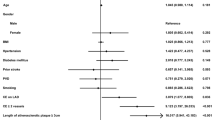Abstract
Objectives
The purpose of this study is to investigate the early and late outcomes of axillary intra-aortic balloon pump (IABP) implantation as a bridge to heart transplantation, comparing the grafted technique with the percutaneous technique.
Methods
Between July 2009 and January 2020, 163 patients underwent an axillary IABP insertion as a bridge to heart transplantation. Among them, 97 patients underwent axillary IABP implantation through a graft sutured onto the axillary artery (Group A) and 66 patients underwent percutaneously (Group B). Propensity matching identified 53 matched pairs for analysis (C-statistics 0.741). The primary outcomes of interest included IABP-related complications, success rate of a bridge to transplantation, in-hospital mortality, and late survival.
Results
In the propensity-score matched cohort, there were no significant differences in the baseline characteristics between the two groups. The operation time was significantly longer in Group A than in Group B (141.5 ± 38.3 min vs 42.7 ± 19.3 min, p < 0.01). The complication rates including stroke, re-exploration for bleeding, and aortic event were not significantly different between Group A and B. However, Group A required more transfusion and re-exploration for bleeding. The success rate of a bridge to transplantation was similar between Group A (47/53, 88.7%) and Group B (47/53, 88.7%). There were no significant differences in in-hospital mortality and late survival between two groups.
Conclusion
In the propensity score matching analysis, there were not any significant differences between the two groups in IABP-related complications, in-hospital mortality, and late survival. The percutaneous technique provided a shorter operation time and less requirement of transfusion and re-exploration for bleeding compared to the grafted technique. The percutaneous technique might be favorable when feasible.

Similar content being viewed by others
References
Norkiene I, Ringaitiene D, Rucinskas K, Samalavicius R, Baublys A, Miniauskas S, Sirvydis V (2007) Intra-aortic balloon counterpulsation in decompensated cardiomyopathy patients: bridge to transplantation or assist device. Interact Cardiovasc Thorac Surg 6(1):66–70
Koudoumas D, Malliaras K, Theodoropoulos S, Kaldara E, Kapelios C, Nanas J (2016) Long-term intra-aortic balloon pump support as bridge to left ventricular assist device implantation. J Card Surg 31(7):467–471
Gjesdal O, Gude E, Arora S, Leivestad T, Andreassen AK, Gullestad L, Aaberge L, Brunvand H, Edvardsen T, Geiran OR, Simonsen S (2009) Intra-aortic balloon counterpulsation as a bridge to heart transplantation does not impair long-term survival. Eur J Heart Fail 11(7):709–714
Fried JA, Nair A, Takeda K, Clerkin K, Topkara VK, Masoumi A, Yuzefpolskaya M, Takayama H, Naka Y, Burkhoff D, Kirtane A, Karmpaliotis D, Moses J, Colombo PC, Garan AR (2018) Clinical and hemodynamic effects of intra-aortic balloon pump therapy in chronic heart failure patients with cardiogenic shock. J Heart Lung Transplant 37(11):1313–1321
Hayes D Jr, Cherikh WS, Chambers DC, Harhay MO, Khush KK, Lehman RR, Meiser B, Rossano JW, Hsich E, Potena L, Sadavarte A, Singh TP, Zuckermann A, Stehlik J (2019) International Society for Heart and Lung Transplantation. The International Thoracic Organ Transplant Registry of the International Society for Heart and Lung Transplantation: Twenty-second pediatric lung and heart-lung transplantation report-2019; Focus theme: Donor and recipient size match. J Heart Lung Transplant 38(10):1015–1027
Estep JD, Cordero-Reyes AM, Bhimaraj A, Trachtenberg B, Khalil N, Loebe M, Bruckner B, Orrego CM, Bismuth J, Kleiman NS, Torre-Amione G (2013) Percutaneous placement of an intra-aortic balloon pump in the left axillary/axillary position provides safe, ambulatory long-term support as bridge to heart transplantation. JACC Heart Fail 1(5):382–388
Umakanthan R, Hoff SJ, Solenkova N, Wigger MA, Keebler ME, Lenneman A, Leacche M, Disalvo TG, Ooi H, Naftilan AJ, Byrne JG, Ahmad RM (2012) Benefits of ambulatory axillary intra-aortic balloon pump for circulatory support as bridge to heart transplant. J Thorac Cardiovasc Surg 143(5):1193–1197
Cochran RP, Starkey TD, Panos AL, Kunzelman KS (2002) Ambulatory intraaortic balloon pump use as bridge to heart transplant. Ann Thorac Surg 74(3):746–751
Organ Procurement and Transplantation Network. Policy 6: Allocation of Hearts and Heart-Lungs. Available at: https://optn.transplant.hrsa.gov/media/2412/adult_heart_approved_policy_lang uage.pdf, Accessed date: 01/02/2022
Huckaby LV, Seese LM, Mathier MA, Hickey GW, Kilic A (2020) Intra-aortic balloon pump bridging to heart transplantation: impact of the 2018 allocation change. Circ Heart Fail 13(8):e006971
Nishida H, Koda Y, Kalantari S, Nguyen A, Chung B, Grinstein J, Kim G, Sarswat N, Smith B, Song T, Onsager D, Jeevanandam V, Ota T (2021) Outcomes of ambulatory axillary intraaortic balloon pump as a bridge to heart transplantation. Ann Thorac Surg 111(4):1264–1270
Yancy CW, Jessup M, Bozkurt B, Butler J, Casey DE Jr, Drazner MH, Fonarow GC, Geraci SA, Horwich T, Januzzi JL, Johnson MR, Kasper EK, Levy WC, Masoudi FA, McBride PE, McMurray JJ, Mitchell JE, Peterson PN, Riegel B, Sam F, Stevenson LW, Tang WH, Tsai EJ, Wilkoff BL (2013) 2013 ACCF/AHA guideline for the management of heart failure: executive summary: a report of the American College of Cardiology Foundation/American Heart Association Task Force on practice guidelines. Circulation 128(16):1810–1852
Bhimaraj A, Agrawal T, Duran A, Tamimi O, Amione-Guerra J, Trachtenberg B, Guha A, Hussain I, Kim J, Kassi M, Xu J, Suarez E, Ngo UQ, Torre-Amione G, Estep JD (2020) Percutaneous left axillary artery placement of intra-aortic balloon pump in advanced heart failure patients. JACC Heart Fail 8(4):313–323
Acknowledgements
We would like to acknowledge the assistance of Team WADA for editorial support.
Funding
None.
Author information
Authors and Affiliations
Corresponding author
Ethics declarations
Conflicts of interest
S. Pinney: Consultant of Abbott, Medtronic. V. Jeevanandam: Consultant of Abbott.
Additional information
Publisher's Note
Springer Nature remains neutral with regard to jurisdictional claims in published maps and institutional affiliations.
Rights and permissions
About this article
Cite this article
Nishida, H., Kalantari, S., Nguyen, A. et al. Clinical outcomes of grafted vs. percutaneous axillary intra-aortic balloon pump support as a bridge to transplantation: a propensity score-matched analysis. Heart Vessels 37, 1995–2001 (2022). https://doi.org/10.1007/s00380-022-02122-y
Received:
Accepted:
Published:
Issue Date:
DOI: https://doi.org/10.1007/s00380-022-02122-y



